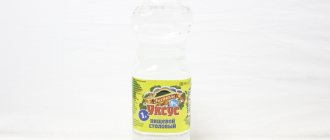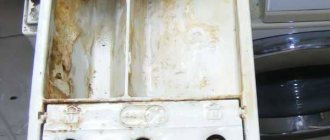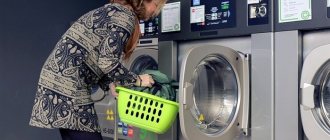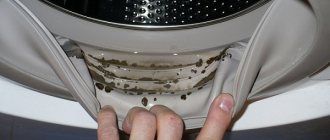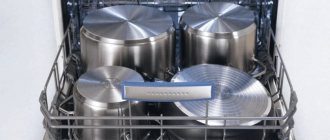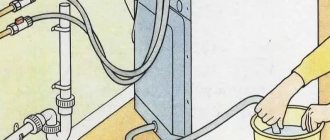From numerous commercials, you know how to clean the heating element of a washing machine, which eventually fails due to hard water. The advertised products are quite expensive, and not everyone can afford to use them constantly.
But, as with many products, you can find equally effective and much cheaper analogues, so next we will look at how to rinse an automatic washing machine with citric acid so as not to harm it and use it for many more years.
Is it possible to clean a washing machine with citric acid?
The operation of the washing machine depends on the quality of the water: if it is hard, scale forms on the heating elements and drum.
Scale prevents water from heating and can damage the heating element. Therefore, when washing, you need to add special water softening agents to the powder. An inexpensive and effective chemical analogue is citric acid. It helps remove hard deposits, mold, limescale and unpleasant odors. Advantages of cleaning a washing machine with citric acid:
- low cost;
- environmental friendliness;
- does not harm metal parts;
- safe for human health.
The acid dissolves quickly in water and does not form sediment.
The substance cleans metal well, but can damage rubber and plastic parts. Therefore, take precautions and adhere to the recommended dosage of the product.
Why clean your washing machine?
City water systems cannot boast of soft and clean water. It contains impurities of metals and salts. We call this kind of water hard. When heated, its impurities form a sediment that remains on the parts of the washing machine.
This process is especially intense at washing temperatures above 60 degrees. The plaque settles, and over time its layer becomes thicker.
This entails negative consequences in the operation of the device:
- Slow heating of water for washing;
- Excessive energy consumption;
- Overheating of parts and subsequent breakdowns.
Limescale is not the only enemy of a washing machine. Rubber parts become damp, mold and fungal organisms grow in them, becoming a source of repulsive odor and causing blockages and jams.
How to choose citric acid
The composition of the powder is the same for each manufacturer. Therefore, when choosing citric acid, pay attention not to the brand, but to the integrity of the packaging: the bag must be dry - if the powder gets wet, it will lose its effectiveness.
For one descaling cycle, you will need about 200 g of citric acid. How many bags to buy depends on the packaging: manufacturers usually pack the powder in 10, 20 and 50 g.
Do not replace the citric acid in the powder with fresh lemon juice. Despite their similar names, they have different compositions and concentrations: lemon juice will not help remove limescale and scale.
Tips and precautions
In order not to harm household appliances and effectively clean them of unnecessary deposits, you should adhere to the following recommendations:
- strictly follow the recommended dosage. Exceeding leads to destruction of rubber and metal elements. If necessary, it is better to repeat the cleaning procedure without increasing the maximum dosage;
- Do not mix citric acid with washing powder. The result of using such a mixture may be unpredictable;
- Do not clean while there is laundry in the drum. Aggressive acid causes fabric to fade and tear;
- Carefully inspect and wipe the inside of the device tank at the end of the procedure. Particular attention should be paid to the rubber seal;
- Do not replace citric acid with lemon juice. The concentration of the latter is too low; the only effect that can be achieved from its use is the elimination of unpleasant odors;
- It is prohibited to disassemble the washing machine and try to remove scale from the heating element mechanically. This will damage the heating element;
To reduce scale formation you should:
- Avoid washing heavily worn or fluffy fabrics;
- more often use a cycle with a heating temperature of 60 to 70 degrees;
- use washing powders containing phosphates;
- remove wet items from the drum immediately after it stops. Wipe all elements dry and ventilate the drum and powder compartment well.
Which washing mode to choose
The solvent properties of citric acid are enhanced by high temperature. Cleaning should be done in a washing mode up to +95℃. If there is little scale, then a temperature of +60℃ is sufficient. Such modes in automatic machines require a long cycle - up to three hours. If you need to set the time in your model yourself, set it to 2–3 hours.
To prevent the acid from damaging individual parts of the machine, you need to thoroughly clean all surfaces after treatment. Therefore, you need to set the double rinse mode and wipe the drum and rubber cuffs well so that no small grains of citric acid remain on them.
How to treat a drum
First - preparation. Before the procedure, make sure that there is no laundry in the drum: acid can damage the fabric. Check to see if there are any small items left inside: buttons, paper clips, paper napkins. Wipe the rubber cuff with a soft, dry cloth or sponge to remove any water droplets or visible dirt.
Don't be afraid to run your washing machine without any laundry. Household appliance repair specialists recommend regularly performing “idle” starts to clean the machine and prevent the formation of solid deposits.
Next, start cleaning the drum:
- Calculate the dosage depending on the size of the machine's tank.
- Pour citric acid into the powder compartment, and if there is mold or an unpleasant odor in the drum, then put the acid directly into the tank.
- Set the mode, turn off the spin and select double rinse.
- Make sure that there are no grains of citric acid left in the drum, and that there is no white residue on the rubber seal.
- At the end of the cycle, open the hatch and thoroughly wipe the powder compartment, drum and door rubber with a rag or sponge soaked in clean water.
- Leave the hatch open and do not use the washing machine for 24 hours to allow all parts to dry.
Be sure to check for damage to the machine parts. There should be no water or citric acid residue anywhere. Inspect the powder and conditioner container, tank, door rubber, all holes and filter screens in front of the drain pump. You can get the mesh by opening the cover on the front panel of the machine.
Instructions
A washing machine is a more complex unit than a kettle or iron. Therefore, to clean it, you should follow certain instructions and procedures.
Preparation
The preparatory stage includes the following steps:
- Checking the drum for the absence of small, accidentally forgotten items (socks, handkerchiefs), foreign objects (buttons, coins) or detergent residues.
- Cleaning the rubber gasket between the tank and the door. It should be wiped with a dry cloth or damp cloth without alcohol.
Read detailed instructions on how to clean your washing machine.
Determine how much to pour and turn on the wash
In order for the effect of using citric acid to be maximum, and the elements of the machine not to be damaged as a result of chemical exposure to them, you should adhere to the dosage recommendations:
- a tank with a volume of 3-4 kg will require 60 g of citric acid. This is approximately 3 tbsp. powder;
- for a tank of 5-7 kg - 75 g of powder (3.5 tbsp);
- for a tank over 7 kg - 100 g or 5 tbsp.
There is no need to dissolve the powder in water; just pour it into the tank of the device.
When cleaning, there should be no laundry in the washing machine, no program, and you can choose any one with a temperature in the range of 60-90 degrees.
It is important that it includes a full washing cycle : soaking, main work, rinsing and spinning (it can be replaced by draining without spinning).
Removing leftovers
After completing the operation of the device, it is necessary to inspect the inside of the drum, remove insoluble grains of acid or pieces of broken plaque from it, and blot off the accumulated moisture.
Wipe the rubber seal and the washing powder container dry. Open the drum door and leave until completely dry for at least a day.
Inspecting the device
The inspection should include checking the following elements:
- washing machine tank;
- sealing rubber, paying attention to folds;
- hidden openings, for example, between the door and the main part of the device;
- mesh filter installed in front of the pump. It can be removed from below into the front of the device;
- container for washing powder.
All listed elements must be in good condition, without any remaining water or powder in it.
How to check equipment for scale?
It is extremely difficult to get to the heating element and visually assess its condition. Without disassembling the household appliance, you can check for scale in the following way:
- Complete the cleaning cycle of the device using citric acid.
- Turn on the device to a maximum temperature of 90-5 degrees.
- Listen to the sounds made. If, in addition to the noise of water, there are extraneous clicks and crackling sounds when it boils, then salt deposits remain on the heating element.
- Additionally, it is worth checking the filter for the presence of large fractions of scale that have lagged behind the heating element. You can perform this operation after the wash cycle has completed.
You can also read here how to clean the rubber band of a washing machine.
How often can you clean your washing machine with citric acid?
Citric acid is an aggressive agent, especially when washing at high temperatures. That is why it copes well with dirt, scale and limescale. In order not to harm the washing machine, you should use this cleaning method no more than once every six months.
If you wash in very hard water, then you need to clean the machine more often - once every 1-2 months.
You also need to clean the tank regularly if you wash frequently: it is recommended to clean it after 30 cycles or every three months.
Sometimes you can tell when it’s time to clean your washing machine based on the following signs:
- deposits have formed on the powder container or drum;
- the time for heating the water and the washing cycle has increased;
- an unpleasant odor appeared in the drum;
- When washing at temperatures above 60℃, the machine makes unusual noise;
- stains or a gray tint appear on the washed laundry;
- The consumption of washing powder has increased.
If you notice at least one sign, you can safely start cleaning your household appliances.
Causes of mold and unpleasant odors
As you know, it is much easier to avoid possible problems than to eliminate their consequences later.
What reasons lead to molding of the machine and provoke a repulsive smell?
Wet drum
Often, in a hurry, having barely pulled out the washed clothes, the housewife slams the door, and the drum of the machine remains wet. And in a humid environment, fungi and other microorganisms multiply. The result is a characteristic musty odor. To ensure everything dries well, you need to wait a few hours.
But it is not recommended to leave the machine open longer, because otherwise the door will begin to sag.
Dirty hatch gasket
- After completing the washing cycle, careful users wipe the wet hatch with a rag so that it does not become overgrown with plaque.
- The same must be done with the rubber gasket. It is multi-layered because it protects the drum.
- And in each layer, various debris and small objects left in clothing pockets, as well as hair, dust and liquid, can get stuck.
- All these factors create a favorable putrefactive environment, hence the smell.
Dirty things in the drum
Sometimes worn clothes are sent to storage in the washing machine long before washing.
- If you regularly follow this habit and close the door at the same time, a strong stench will become a constant companion of your household appliance.
- It is much more convenient to use a special basket for storing dirty clothes, choosing it to match the style of the interior and the desired size.
Installation curve
If the machine is not level on the floor, it may not be completely free of water after washing. Where the slope is least, liquid will stagnate, the presence of which you will recognize by the repulsive smell of dampness and rot.
Clogged drain hose
Cleaning this spare part is a labor-intensive and practically useless process. If the hose is faulty, it is much better to replace it with a new one.
Quality and quantity of laundry detergents
Poor quality detergents do not completely dissolve in water, so they settle on the walls of the machine.
- The same thing happens with excessive use of even very expensive products.
- They are not completely washed out and also become sediment.
- And subsequently the reason for not the best aroma.
Dirty powder tray
This is the case when the reason is literally on the surface. If the tray itself is dirty, then the channel through which the detergents go deep into the machine will not be clean.
Clogged filter
This is the most common cause of odor. To keep the filter clean as long as possible, do not allow foreign objects or loose fasteners to get into the drum.
Once stuck in the filter, they accumulate smaller particles around them, preventing the liquid from passing freely.
heating element
If the heating element is covered with scale, the stench will be especially strong. After all, other dirt also sticks to the coating. It produces a particularly intense odor when washed in medium-temperature water.
Malfunctions in the sewer system
In this case, there will be an unpleasant odor not only in the drum, but also in the sink and bathtub drains.
Alternative methods at hand
Citric acid is not the only home remedy that will help clean your washing machine and get rid of unpleasant odors.
Table vinegar
Regular table vinegar can deal with scale: it quickly destroys hard deposits and removes limescale. Here's what to do:
- Pour 150 ml of 4% vinegar into the detergent compartment or directly into the drum and start the wash.
- During washing, you can pause the machine to allow the acetic acid to soften the dirt.
- Start rinsing.
After the procedure, be sure to wipe the tank and the rubber of the hatch with a damp cloth and open the door to let the car dry.
Baking soda
To remove limescale from your car, you can use baking soda. Procedure:
- Dissolve soda in water in a 1:1 ratio.
- Soak a napkin in the solution and thoroughly wipe all visible elements: drum, powder compartments, door rubber.
- Time it for 25 minutes.
- Set the machine to quick wash mode and start working.
- Finally, turn on the rinse mode.
To enhance the effect, use baking soda and vinegar:
- Prepare a solution by mixing vinegar and soda in equal proportions (0.5 cups each).
- Pour the resulting mixture into the washing powder compartment.
- Additionally, pour a glass of vinegar into the drum.
- Set the temperature to maximum and start the wash.
- Finally, open the door to let the machine dry.
White
Another inexpensive way is to use white. With its help you can get rid of bacteria, scale, dirt and plaque. What to do:
- Add white to the washing powder compartment (from 0.5 to 1 bottle depending on the degree of soiling of the machine).
- Set the maximum washing temperature (at least +90℃) and start the machine.
- At the end of the cycle, turn on the rinse mode.
The disadvantage of this method is the risk of damage to internal parts and a specific persistent odor. To get rid of it, add a glass of table vinegar to the powder compartment and run the quick wash cycle.
About the advantages and disadvantages
Citric acid as a descaling agent has several advantages:
- availability and reasonable price tag. Crystalline powder is available in almost any store and is suitable even for the most budget-conscious;
- effectiveness. The effect of citric acid used to clean a washing machine is noticeable: unpleasant odors, mold, scale and rust disappear;
- ease of use. No tricky dosage regimens or long and multi-step processes are required to achieve results. Everything is extremely simple.
Citric acid can corrode rubber in the washing machine. This can be considered a disadvantage, if you do not take into account some points:
- rubber seals (door gasket) often suffer from fungus, which also has destructive properties;
- correct dosage and not too frequent use (mandatory rinsing after the procedure) avoid problems with rubber;
- Rubber seals can be removed before cleaning or replaced with new ones if damaged.
Another relative disadvantage is the specific acidic smell from the drum and washed items. A couple of wash cycles and the smell disappears, but not everyone likes it. Although the unobtrusive lemon aroma is far from the most unpleasant thing that a washing machine drum can smell of!
Alternative special means
Let's look at popular products.
Dr. Beckmann
- a German cleaner that can be used for all internal elements of washing machines: drum, heating element, pipes. The cleaner eliminates unpleasant odors, scale, and limescale.
To clean the tank, pour 250 g of powder into the machine drum and turn on the wash at +60℃. There is no need to add other detergents or use a prewash program. The laundry should be removed from the tank. Repeat the procedure every 2–3 months
Topper
— express cleaner from Italy for automatic machines. Removes scale, plaque, dirt, and odor. Safe for metal plastic and rubber machine parts. Before using it, you need to empty the tank of laundry, pour the product into the drum, set the temperature to 60℃ without pre-washing. The manufacturer recommends using the product no more than three times a year.
MAGIC POWER
produced in Germany and shows excellent results in removing scale. The product removes limescale from the surface of the drum and tank. Sold in liquid form of 250 ml. The product must be poured into the washing powder compartment and the wash cycle started.
conclusions
- If the water takes a long time to heat up during washing, the drum smells unpleasant, and stains and stains appear on the clothes after washing, this is a reason to clean the washing machine.
- You can use folk remedies: citric acid, vinegar or whiteness. The detergents are poured into the tank and the washing mode is set to high temperature. After the procedure, you need to thoroughly rinse the drum and other parts of the machine so as not to damage the equipment. If you are afraid of doing something wrong, it is better to buy special household chemicals.
- To prevent the appearance of solid deposits, experts recommend washing clothes at a temperature of no more than +65–70℃ and using high-quality washing powders and gels. In regions with hard water, special store-bought products will protect you from scale.
Scale problems
How often have you noticed that the washing machine began to work poorly, take a long time to heat up, consume more electricity than it should, and do not cope well with its washing task.
If you notice at least one malfunction in the operation of your automatic washing machine, then most likely the heating element called the heating element is covered with a mixture of carbonate salts.
This happens because the washing machine for its intended purpose uses the most ordinary tap water, which, in comparison with that purified through filters, has increased hardness due to a high concentration of impurities in the form of salts.
Constantly washing clothes in an automatic machine will certainly lead to deposits on the parts, which appear not only due to water, but also from low-quality powders, as well as from the clothes themselves.
The main problems that may arise are:
- Excessive consumption of electricity. Ten works under pressure, trying to reach the desired temperature through all layers of scale. Consequently, this takes more time, and subsequently you will have to overpay for electricity.
- Operating in this mode, the heater may fail.
- Over time, plaque may appear not only on the parts, but also on the drum itself.
Based on the possible unpleasant consequences that can happen to your machine during operation, you need to know how to clean the heating element of a washing machine from scale. Repairing a washing machine costs a lot of money, but knowing how much, where and how to pour lemon juice at home, you can sort out the problem in a couple of hours.
